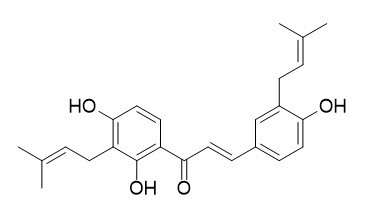Kanzonol C
Kanzonol C has antimicrobial activity, it also shows potent PTP1B inhibitory activity (IC50 value of 0.31-0.97uM). Kanzonol C has chemopreventive activity,it shows the inhibition of matrix metalloproteinase (MMP)-2 secretion from brain tumor-derived glioblastoma cells.
Inquire / Order:
manager@chemfaces.com
Technical Inquiries:
service@chemfaces.com
Tel:
+86-27-84237783
Fax:
+86-27-84254680
Address:
1 Building, No. 83, CheCheng Rd., Wuhan Economic and Technological Development Zone, Wuhan, Hubei 430056, PRC
Providing storage is as stated on the product vial and the vial is kept tightly sealed, the product can be stored for up to
24 months(2-8C).
Wherever possible, you should prepare and use solutions on the same day. However, if you need to make up stock solutions in advance, we recommend that you store the solution as aliquots in tightly sealed vials at -20C. Generally, these will be useable for up to two weeks. Before use, and prior to opening the vial we recommend that you allow your product to equilibrate to room temperature for at least 1 hour.
Need more advice on solubility, usage and handling? Please email to: service@chemfaces.com
The packaging of the product may have turned upside down during transportation, resulting in the natural compounds adhering to the neck or cap of the vial. take the vial out of its packaging and gently shake to let the compounds fall to the bottom of the vial. for liquid products, centrifuge at 200-500 RPM to gather the liquid at the bottom of the vial. try to avoid loss or contamination during handling.
Int J Mol Sci.2020, 21(22):8816.
Pharmaceuticals (Basel).2024, 17(3):352.
J Pharm Biomed Anal.2024, 247:116257.
Mol Cancer Ther.2024, 1535-7163.
Planta Med.2024, 2328-2750
Appl Microbiol Biotechnol.2024, 108(1):207.
Food Funct.2022, D1FO03838A.
STAR Protoc.2024, 5(2):102990.
Kyung Hee University2024, rs-3888374
Neurochem Res.2021, s11064-021-03449-0
Related and Featured Products
Bioorg Med Chem. 2017 Jul 15;25(14):3706-3713.
Screening for bioactive natural products from a 67-compound library of Glycyrrhiza inflata.[Pubmed:
28522265]
Licorice shows a variety of pharmacological activities. This work aims to discover bioactive natural products from one botanical source of licorice, Glycyrrhiza inflata. A total of 67 free phenolics were isolated to form a compound library.
METHODS AND RESULTS:
Based on the bioactivities of licorice, these compounds were screened using cell- or enzyme-based bioassay methods. A total of 11 compounds exhibited potent cytotoxic activities against three human cancer cell lines (HepG2, SW480 and MCF7), while showed little toxicity on human normal cell lines LO2 and HEK293T. A number of chalcones showed remarkable anti-inflammatory activities. Among them, 2 (licochalcone B, IC50 8.78μM), 10 (licoagrochalcone C, IC50 9.35μM) and 13 (licochalcone E, IC50 9.09μM) exhibited the most potent inhibitory activities on LPS-induced NO production, whereas 1, 8, 10, 12 and 13 (IC50 13.9, 7.27, 2.44, 6.67 and 3.83μM) showed potent inhibitory activities on NF-κB transcription.
CONCLUSIONS:
Nine prenylated phenolics were found to be PTP1B inhibitors. Particularly, licoagrochalcone A (4), Kanzonol C (7), 2'-hydroxyisolupalbigenin (35), gancaonin Q (45), glisoflavanone (50) and glabrol (53) showed IC50 values of 0.31-0.97μM. Compounds 24 (semilicoisoflavone B, IC50 0.25μM), 26 (allolicoisoflavone B, IC50 0.80μM) and 64 (glabridin, IC50 0.10μM) showed noticeable tyrosinase inhibitory activities.
Most of the above bioactive compounds were reported for the first time.
J Ethnopharmacol. 2008 Mar 28;116(3):483-9.
Antimicrobial activity of the crude extracts and five flavonoids from the twigs of Dorstenia barteri (Moraceae).[Pubmed:
18280679 ]
The aim of this study was to evaluate the antimicrobial activity of the crude extract of the twigs of Dorstenia barteri (DBT) as well as that of four of the five flavonoids isolated from this extract.
METHODS AND RESULTS:
Gram-positive bacteria (six species), Gram-negative bacteria (12 species) and fungi (four species) were used. The agar disc diffusion test was used to determine the sensitivity of the tested samples while the well micro-dilution was used to determine the minimal inhibition concentrations (MIC) and the minimal microbicidal concentration (MMC) of the active samples. The results of the disc diffusion assay showed that DBT, isobavachalcone (1), and Kanzonol C (4) prevented the growth of all the 22 tested microbial species. Other compounds showed selective activity. The inhibitory activity of the most active compounds namely compounds 1 and 4 was noted on 86.4% of the tested microorganisms and that of 4-hydroxylonchocarpin (3) was observed on 72.7%. This lowest MIC value of 19.06microg/ml was observed with the crude extract on seven microorganisms namely Citrobacter freundii, Enterobacter aerogens, Proteus mirabilis, Proteus vulgaris, Bacillus megaterium, Bacillus stearothermophilus and Candida albicans. For the tested compounds, the lowest MIC value of 0.3microg/ml (on six of the 22 organisms tested) was obtained only with compound 1, which appeared as the most active compound. This lowest MIC value (0.3microg/ml) is about 4-fold lower than that of the RA, indicating the powerful and very interesting antimicrobial potential of isobavachalcone (1). The antimicrobial activities of DBT, as well as that of compounds 1, 3, 4, amentoflavone (5) are being reported for the first time.
CONCLUSIONS:
The overall results provide promising baseline information for the potential use of the crude extracts from DBT as well as some of the isolated compounds in the treatment of bacterial and fungal infections.



